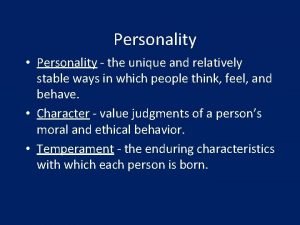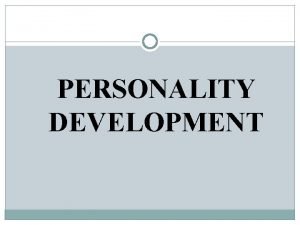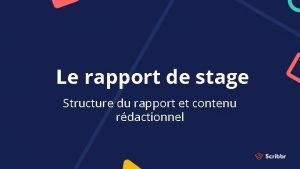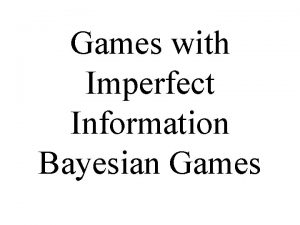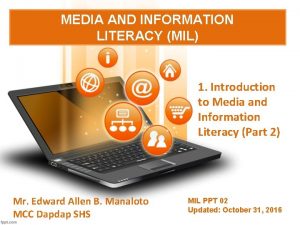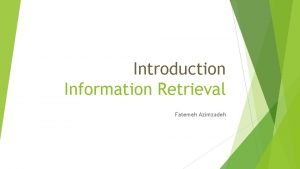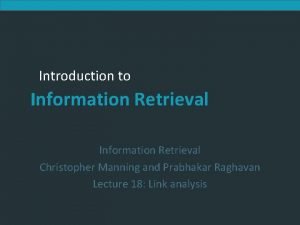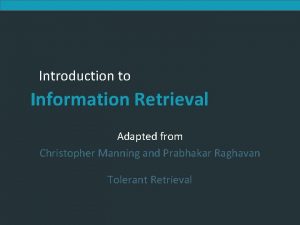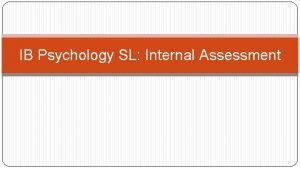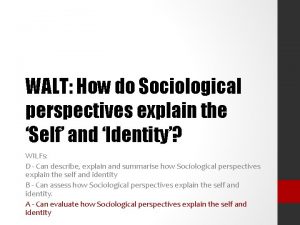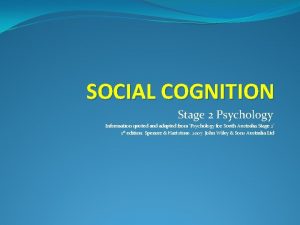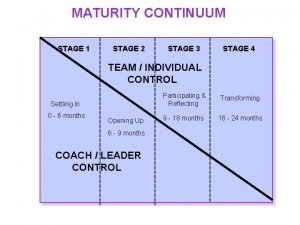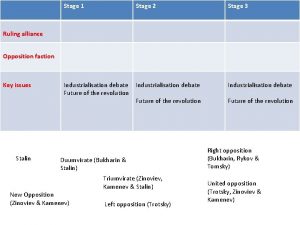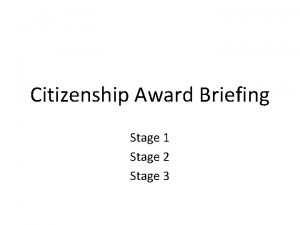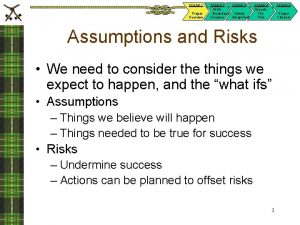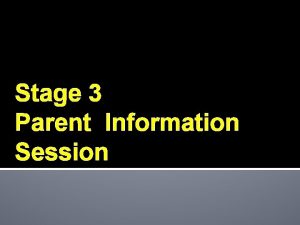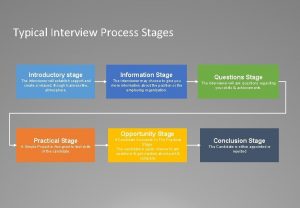INTRODUCTION TO PSYCHOLOGY Stage 2 Psychology Information quoted

















































































- Slides: 81

INTRODUCTION TO PSYCHOLOGY Stage 2 Psychology Information quoted and adapted from ‘Psychology for South Australia Stage 2’ 1 st edition. Spencer & Hartstone. 2007. John Wiley & Sons Australia Ltd.

WE HAVE A WEEBLY PAGE! http: //stage 2 psychatfaith. weebly. com Save this as a bookmark in your browser – will use it every lesson

What is Psychology? Systematic study of thoughts, feelings and behaviour and the factors which influence these. There is still much of the field of Psychology that is ‘unknown’. Much debate and varying opinions amongst Psychologists about psychological concepts. No definitive answers. Goals of Psychology are to describe, predict, control and explain thoughts, feelings and behaviours.

FOUR LEVELS OF EXPLANATION OF BEHAVIOUR Year 12 Psychology

Four Levels of Explanation Refers to different approaches to understanding and explaining behaviour: 1. 2. 3. 4. The biological level The basic processes level The person level The socio-cultural level All needed to develop holistic perspective on behaviour Each topic we go though this year will focus on one of the above levels. Healthy minds will bring them all together.

BIOLOGICAL Focuses on the biological, physical and chemical processes underlying behaviour. Factors: heart rate, blood pressure, galvanic skin response, hormones, substances (alcohol or drugs) sleep and stress. Psychobiology of Altered States of Awareness focus topic. Content from this topic is from the biological level.

BASIC PROCESSES Focuses on psychological processes that are widespread amongst humans. Factors: emotions, learning, perception, memory, cognition. Learning focus topic. Content from this topic is from the basic processes level.

PERSON Focuses on individual differences in behaviour. Factors: age, gender, personality type. Personality focus topic. Content from this topic is from the person level.

SOCIO-CULTURAL Focuses on the influence that other people have on behaviour by studying behaviour in social contexts. Factors: onlookers, family, friends, culture, community. Social Cognition focus topic. Content from this topic is from the socio-cultural level.

FOUR LEVELS OF EXPLANATION Once each topic is finished, we will revisit the level of explanation that the topic is linked to. Topics and levels: Altered States of Awareness = Biological Learning = Basic Processes Personality = Person Social Cognition = Socio-cultural

Scientific Nature of Psychology approaches the study of behaviour in a scientific way. This involves the use of the scientific method. Scientific method: systematic approach for planning, conducting, and reporting research that involves collecting empirical evidence. Empirical evidence: data (or information) collected directly by observation or experimentation. Allows Psychologists to draw accurate conclusions which tend to be free of personal bias.

RESEARCH DESIGNS Introduction to Psychology

RESEARCH DESIGNS Data is collected using one or more investigation designs. A design is the way in which an investigation is set up or designed. Type of design chosen depends on the hypothesis or question of the researcher. Three types: 1. Experimental 2. Quantitative Observational 3. Qualitative

EXPERIMENTAL Used to test wether one variable or factor influences or causes a change in another variable. Controlled Experiment: Control group: does not receive the treatment (IV) Experimental group: does receive the treatment (IV) Presence of control group provides standard of comparison against which the researcher can compare the groups results in order to determine if the IV had an effect. Often, participants do not know which group they are allocated to. This is to ensure participants expectations don’t influence the results. Process called single-blind procedure.

EXPERIMENTAL Controlled Experiment Variables: Independent Variable (IV): Manipulated/changed/controlled by the researcher. Dependent Variable: (DV): Measured as a result of the IV. Determines cause and effect relationship between variables.

EXPERIMENTAL Variables (cont. ) Extraneous variables: a variable other than the IV that can cause a change in the DV. Makes it very difficult to conclude that changes have occurred in the DV have resulted because of the IV and not some other variable.

EXPERIMENTAL Controlled Setting Experimental designs are usually conducted in controlled conditions such as a laboratory. E. g. : examining the effects of coffee on reaction times. Participants kept in laboratory to observe the effects of caffeine on their reaction to certain stimuli.

EXPERIMENTAL Random assignment/random allocation Participants are just as likely to be in the experimental group as the control group. Goal is to obtain groups that are as alike as possible in terms of characteristics before the IV is introduced. Can conclude that any change in behaviour, thoughts or feelings is as a result of IV.

ESSENTIAL CHARACTERISTICS Presence of a control group Random assignment/allocation Hypothesis testing Pre and post testing Cause and effect relationship established Controlled environment (such as lab)

ADVANTAGES Maximises control over extraneous variables affecting the DV. Can determine cause and effect relationship between IV and DV (if the IV caused and effect on the DV). Controlled setting allows for easy replication of experiment. Cause and effect relationship can be determined.

DISADVANTAGES May be unethical to manipulate certain variables or randomly allocate participants. Controlled setting may make it inapplicable to real world (lacks external validity). May not represent entire population.

QUANTITATIVE OBSERVATIONAL Used when pre-existing criteria or characteristics are present, such as gender, ethnicity, job status etc. Experimenter may choose quantitative observational because: Too costly to set up experimental design Want to examine pre-existing characteristic anyway Too unethical to manipulate IV E. g. too unethical to randomly allocate children into groups to play violent video games if never been exposed to them. Would use children who have already played violent video games and children who have never played them previously.

QUANTITATIVE OBSERVATIONAL Have some characteristics which are similar to an experimental research design. Both have IV and DV Can still have control group Both can be done in a controlled way However, different to experimental in that: IV is NOT manipulated Groups are NOT randomly allocated Usually done in natural setting of participants. Can’t imply causation with QO

ESSENTIAL CHARACTERISTICS Independent variable is NOT manipulated Allows for research in a natural setting Can determine associations between variables but CAN NOT determine cause and effect.

ADVANTAGES Allows study of variables that are too unethical, impossible or too costly to manipulate i. e. violent video games etc. Human behaviour can be observed in natural setting. May allow for bigger sample sizes.

DISADVANTAGES Can not infer cause and effect relationship between variables as greater chance of extraneous variables. Hard to replicate study due to natural setting. Observer bias can affect the results.

QUALITATIVE Used to gain in-depth qualitative data about a topic. Two main types: Focus group Delphi technique

QUALITATIVE Focus group A group interview that obtains data through discussion between research participants. Participants encouraged to talk with one another, ask questions, exchange personal experiences and points of view etc. A facilitator guides the discussion to make sure everyone expresses their views. Usually between 6 – 15 people however can be bigger. Key feature: participants are not experts in field of study.

QUALITATIVE Delphi technique Uses a series of self administered questionnaires and feedback to obtain the opinion of experts in the field of interest. Usually data is in written format. Experts do not need to be together to give data to researcher Questionnaires used to gain consensus on topic.

ADVANTAGES Can be much more convenient. Can gain significant rich, verbal data. Very useful if little is known about a topic. Can start with qualitative data and then from findings, develop other designs.

DISADVANTAGES Can not generalise results due to subjective nature. Presence of facilitator and/or others can affect what is said. Personal bias/extraneous variables can affect data.

EXAM QUESTIONS 1. Focus groups are an example of one type of investigation design. State the name of the type of design. (2 marks) Answer: Qualitative

EXAM QUESTIONS 2. Describe one disadvantage of using an experimental research design. (2 marks) One disadvantage of an experimental design is that it may not apply to the real world due to such controlled setting. OR • Sample may not represent population • May have ethical concerns (harm to participants) • May be too costly • Too impractical due to variables already studying

EXAM QUESTIONS A group of volunteers take part in a study to measure the effects of heart rates on watching a frightening movie. The volunteers are allocated randomly to one of two different groups of equal size. One group watches the frightening movie and the other does not. Identify the investigation design used (1 mark) Experimental Justify your answer to part a using the information provided. (2 marks) Use of control group – one group watches a movie that is not frightening. Gives the researcher a basis for comparison to the other group. Manipulation of IV – able to manipulate if watching movie or not. Random allocation – researcher randomly allocated participants into groups – ensures the groups are as equivalent as possible. 3 marks total

RESEARCH METHODS Introduction to Psychology

RESEARCH METHODS Tools or techniques psychologists use to obtain data. In other words, type of data collected. Three types: Objective quantitative Subjective quantitative Qualitative

RESEARCH METHODS Objective Free from bias/opinion/personal interpretation. Subjective Can be altered by bias/opinion/personal interpretation. Quantitative Data using numbers Qualitative Data using words, language, pictures.

OBJECTIVE QUANTITATIVE Objective Quantitative Measures Standardised Tests: Scores on test have the same meaning with the same questions. Used the same way on each occasion. Also referred to as ‘standardisation’ Physiological Measures Measure of body functions e. g. heart rates, galvanic skin response, blood pressure etc. Sometimes a polygraph machine used. Behaviour Counts Specific behaviour frequency recorded during a given period of time. Can not argue with the results. Free from opinion, bias etc.

SUBJECTIVE QUANTITATIVE Subjective Quantitative Measures Rating scales Participants select their response from a fixed statement. Likert scale frequently used. ‘Psychology is awesome’ 1=strongly agree, 2=agree, 3=neutral, 4=disagree, 5=strongly disagree Questionnaires – with fixed response answers (eg yes/no answers, multiple choice answers or rating scales) They allow the opportunity to ask the same questions of a large portion of people.

QUANTITATIVE RESEARCH Advantages Usually done in controlled conditions so more likely to be valid Can be directly verified if objective, improving validity Disadvantages Doesn’t explain results, only shows numbers Still may be bias if it is subjective

QUALITATIVE Questionnaires Interviews Pictures Descriptions Any data using language, pictures etc.

QUALITATIVE RESEARCH Advantages Provides rich and deep data about research topic Can get expert opinion with Delphi technique Useful if little is known about topic – researchers starting point Disadvantages Usually quite subjective, even if using Delphi technique Unable to be verified in controlled setting

MEASURING DATA IN PSYCHOLOGY Introduction to Psychology

MEASURING DATA Descriptive statistics Statistics that are used to organise and describe quantitative data so that they can be interpreted. Often summarised by determining a single numerical score that can describe the data for whole group. This is called central tendency. Most common measures for central tendency are: Mean Median Mode

MEAN Most commonly used in central tendency. Also known as the ‘arithmetic average. ’ Adding values together then divide by the total number of values: 3, 4, 5, 7, 2, 3, 5 3+4+5+7+2+3+5 = 29 29/7 = 4. 1

MEDIAN Score found in exact middle of distribution. Used when extreme outliers are present in distribution. Calculated by placing values in ascending order and finding the middle number: 3, 4, 6, 7, 8, 10, 125 = 7 3, 4, 6, 7, 8, 10 = 6+7 = 13/2 = 6. 5 E. g. 3, 4, 6, 7, 8, 10, 125 outlier > the mean = 23. 2 = skewed

MODE Most frequently occurring value in a set of scores. Only used when data is in categories. Calculated by counting which value occurs the most: 2, 3, 4, 4, 5, 5, 5, 6, 7 = 5 (occurs three times)

GRAPHICAL REPRESENTATION Data in graphic form to further make inferences about the data. Graphs: Line graphs: indicates relationship between two variables in an experiment e. g. amount of sleep a person has had and how tired they report feeling. Bar graphs: shows how frequently a particular category of data occurs by using a series of bars that do not touch e. g. males vs. female responses. Histograms: show the frequency with which a particular score occurs in a set of data. Different to bar graphs because the bars touch and represents continuous data, such as age and time.

LINE GRAPH

BAR GRAPH

HISTOGRAM

SCATTERPLOT

NORMAL DISTRIBUTION Most of the data are located in the centre of the distribution, then tapers out to a few extremely high or extremely low score either side of the middle. Ideal result for researchers however hard to achieve due to more extreme scores.

NORMAL DISTRIBUTION

SKEWED DISTRIBUTION Sometimes the scores are unevenly distributed and cluster to the left or right of the graph. Positively skewed: a curve skewed to the left, indicating a clustering of large number of ‘low’ scores. Negatively skewed: a curve skewed to the right, indicating a clustering of large number of ‘high’ scores.

POSITIVE AND NEGATIVE SKEW

DISPERSION Variability of the values around the central tendency (mean, median and mode). Range used to calculate difference between highest and lowest score in a set of scores. Standard deviation most common measure of dispersion. Standard deviation: average distance between scores in a distribution and the mean.

STANDARD DEVIATION Normal distribution has the majority of scores fall in the middle, so the mean, median, mode have the same value. Scores that cluster closely around the mean have a small standard deviation. Scores that are wide spread from the mean have a large standard deviation.

STANDARD DEVIATION Example: A replacement teacher comes to a new school hoping for an easy days work. The teacher is offered either of two classes, both with a mean IQ score of 100. the standard deviation for one class is 2, and the standard deviation for the other class is 5. Since higher standard deviation means more variability in the data, the class with the SD of 5 may take more effort because they vary more in ability.

INFERENTIAL STATISTICS Inferential statistics use mathematics to draw conclusions from the results of a study (to compare the sample to the population). They allow the Psychologist to determine from the results, what conclusions can be drawn and if any generalisations can be made, but most importantly, whether the results are statistically significant. Inferential statistics can be used to assess the differences between control and experimental groups to see if the IV affected the DV.

CONTENT ANALYSIS The process of collating and analysing qualitative data, most often from a focus group. Uses coding process to make sense of qualitative data: 1) Familiarity of data 2) Looks for reoccurring words, phrases, that relate to question (themes). 3) Examine themes to find consistencies, patterns. 4) Identify common themes, label them. 5) Count number of times themes occur in data. 6) Present frequency distribution.

EVALUATING DATA IN PSYCHOLOGY Introduction to Psychology

EVALUATING DATA An important goal in psychology is to obtain results that are both reliable and valid. Need to determine if data is high in validity (accuracy) and reliability (consistency). Also need to determine if the sample size is big enough to represent the population in question.

VALIDITY The degree to which a research study has produced results that accurately measure what it claimed to measure. Example: measuring your reaction time with a faulty stop watch = low validity as not an accurate measure of reaction time. External validity: wether the results obtained from a lab or controlled setting would be valid in the real world. Example: laboratory not good conditions to measure certain things like love, grief or hate.

RELIABILITY The extent to which an experiment yields the same results on repeated trails (so the degree of stability exhibited when a measure is repeated under identical conditions. ) For example: measuring height with a ruler and then double checked it, should get same result = high reliability. A measure can be reliable without being valid, but a measure cannot be valid unless it is reliable. Examples?

VALIDITY AND RELIABILITY Biggest threat to validity and reliability are extraneous variables. Also, researcher making impossible conclusions and not giving accurate instruction.

SAMPLE AND POPULATION Sample: a subsection or smaller group of research participants selected from a larger group of interest, called the population. Population: entire group of research interest from which the sample is drawn. Example: researcher interested in television ratings in Adelaide. The population would be all people with televisions. The sample would be the actual participants in the research.

SAMPLE SIZE Important to consider wether sample size is big enough to draw conclusions from. 30 participants used for attitudes towards migration? The more participants in a study, the more data can be collected = more consistent conclusions can be drawn.

REPRESENTATIVENESS Important that participants represent the whole population in question. Studying societies attitudes towards migration: Using all female participants between 20 and 40 years Using both genders equally aged between 18 -75

ETHICS IN PSYCHOLOGY Introduction to Psychology

ETHICS Researcher must take into consideration obvious or potential ethical issues involved. Researchers responsibility that participants are not put under major physical, mental, emotional, financial stress or harm. Researchers must follow five key ethical principles: Informed consent Voluntary participation Confidentiality Right to withdraw Debriefing

INFORMED CONSENT Participants need to be appropriately informed of the type of study and the reasons for the research prior to agreeing to participate. Informed of all rights, risks and aim of investigation. Informed of right to withdraw. First language to participants. Must never involve bribery or coercion. Consent form essential. Participants under 18 must have parent/caregiver consent.

VOLUNTARY PARTICIPATION Researcher needs to ensure that participants consent to be involved in the research voluntarily. Participants can not be bribed, threatened or coerced. No negative consequences for refusal.

CONFIDENTIALITY Participants have the right to privacy so any details of their involvement cannot be disclosed unless written consent is obtained. No personal information released (names, addresses etc. ) Anonymity is acceptable. Often ID numbers allocated to participants. Applies to storage of data, access of data, publication.

RIGHT TO WITHDRAW Researcher must inform participants they may withdraw from the study at any time without explanation. Will not incur any negative consequences Sometimes researcher will withdraw participant/s themselves.

DEBRIEFING Participants are debriefed of the purpose of the research. Researcher explains process of what will occur with the data. Answers any questions participants may have. Informs participants of deception (if any).

OTHER ETHICAL CONSIDERATIONS Introduction to Psychology

ACCURATE REPORTING Researchers have a duty to publish their results. Give complete information about research. Can not fabricate results. Take credit for other psychologists/researchers work.

DECEPTION Some investigation needs bias to establish data. Only done if no significant physical, emotional, psychological, financial or social harm is done. Only used if there is no other way to achieve aim of research. Must be informed in debriefing.

GENERAL WELLBEING The wellbeing of participants needs to always be taken into account before, during and after any research study. Researcher/s must ensure no general harm is coming to participant, nor any potential consequences after the study is completed. Example: not ethical to make children eat unhealthy food to measure activity levels – children could stay overweight which could impact on their health.

USE OF ANIMALS IN RESEARCH Code of ethics in Australia is very strict. Researcher needs to consider: Welfare of the animal Use of animal justified Avoid pain and distress Know the correct maintenance, care and handling of animal
 Quoted and reported speech
Quoted and reported speech Nonfiction signpost examples
Nonfiction signpost examples Word gaps signpost
Word gaps signpost Two types of adjustments to list or quoted price are
Two types of adjustments to list or quoted price are Quoted material examples
Quoted material examples Reported speech revision
Reported speech revision Tom said i want to visit my friends this weekend
Tom said i want to visit my friends this weekend Quoted speech vs reported speech
Quoted speech vs reported speech 1. denial
1. denial The position of the acting area in relation to the audience
The position of the acting area in relation to the audience What is flexible staging
What is flexible staging Two stage tender
Two stage tender The word drama comes from
The word drama comes from Stage right and stage left
Stage right and stage left Anal stage psychology definition
Anal stage psychology definition Freud's personality theory
Freud's personality theory Latent fixation
Latent fixation Introduction stage of fashion cycle
Introduction stage of fashion cycle Accroche rapport de stage
Accroche rapport de stage Complete vs perfect information
Complete vs perfect information Positive psychology ap psychology definition
Positive psychology ap psychology definition Social psychology definition psychology
Social psychology definition psychology Fundamental attribution error ap psychology
Fundamental attribution error ap psychology Scope of clinical psychology
Scope of clinical psychology Social psychology definition psychology
Social psychology definition psychology Health psychology definition ap psychology
Health psychology definition ap psychology How to create an introduction paragraph
How to create an introduction paragraph What is management information systems
What is management information systems Introduction of management information system
Introduction of management information system Thesis statement
Thesis statement Introduction to information technology
Introduction to information technology Introduction to information systems 6th edition
Introduction to information systems 6th edition What is information
What is information Background information introduction
Background information introduction White-collar workers คือ
White-collar workers คือ Media information and technology literacy venn diagram
Media information and technology literacy venn diagram Poster about importance of media and information literacy
Poster about importance of media and information literacy Mis chapter 1
Mis chapter 1 Introduction to information systems 3rd edition
Introduction to information systems 3rd edition Introduction to management information systems 5th edition
Introduction to management information systems 5th edition Introduction of ict
Introduction of ict Accounting information system chapter 1
Accounting information system chapter 1 Introduction to information visualization
Introduction to information visualization Introduction to information retrieval
Introduction to information retrieval Introduction to ict
Introduction to ict Introduction of student information system project
Introduction of student information system project Introduction to information systems 3rd edition
Introduction to information systems 3rd edition Introduction to information security chapter 2
Introduction to information security chapter 2 Introduction to information retrieval
Introduction to information retrieval Introduction to information technology: your digital world
Introduction to information technology: your digital world Introduction to information technology: your digital world
Introduction to information technology: your digital world Introduction to information systems 3rd edition
Introduction to information systems 3rd edition Introduction to information retrieval
Introduction to information retrieval Manning information retrieval
Manning information retrieval Siop jobnet
Siop jobnet Anthropology psychology and sociology
Anthropology psychology and sociology Introduction to industrial psychology
Introduction to industrial psychology Introduction to psychology chapter 1
Introduction to psychology chapter 1 Health psychology definition
Health psychology definition Introduction to forensic psychology bartol pdf
Introduction to forensic psychology bartol pdf Anthropology psychology and sociology
Anthropology psychology and sociology Introducción a la psicología psychology: an introduction
Introducción a la psicología psychology: an introduction Introduction to psychology lecture
Introduction to psychology lecture Rod plotnik introduction to psychology
Rod plotnik introduction to psychology Introduction to anthropology psychology and sociology
Introduction to anthropology psychology and sociology Chapter 1 introduction to psychology
Chapter 1 introduction to psychology Ib psychology ia exploration
Ib psychology ia exploration Unit 1 introduction to psychology
Unit 1 introduction to psychology Unit 1 introduction to psychology
Unit 1 introduction to psychology Waymaker psychology
Waymaker psychology Introduction to psychology chapter 1
Introduction to psychology chapter 1 Introduction to psychology chapter 1
Introduction to psychology chapter 1 Conclusion paragraph format
Conclusion paragraph format Derivational relations stage
Derivational relations stage Stage directions in a script
Stage directions in a script Within word pattern spelling stage
Within word pattern spelling stage Culmination stage fashion
Culmination stage fashion Foundation stage 2
Foundation stage 2 George herbert mead i'' and me
George herbert mead i'' and me True labor contractions
True labor contractions Aside definition drama
Aside definition drama Cognitive associative and autonomous stages of learning
Cognitive associative and autonomous stages of learning














